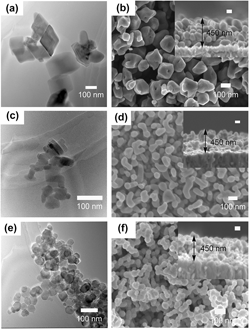Published online by Cambridge University Press: 16 February 2016

In this study, hematite nanoparticles (α-Fe2O3 NPs) were synthesized by hydrothermal method, with morphologies (e.g., nanorhombohedra, nanobars, and nanospheres) facilely tuned by changing the concentrations of glycol in the hydrothermal solution. Then a low-cost and scalable electrophoretic deposition method was used to fabricate nanostructured α-Fe2O3 films as photoanodes for solar hydrogen generation. It was found that the film of α-Fe2O3 nanobars showed the highest photoelectrochemical (PEC) performance compared to those films of α-Fe2O3 nanorhombohedra and nanospheres, with photocurrent density reaching 0.7 mA/cm2 at 0.6 V versus Ag/AgCl. This PEC improvement may be related to the smaller diameters of nanobars shortening the carrier migration distance, reducing the recombination rate of photo-generated carriers. Moreover, all the α-Fe2O3 films showed much higher PEC performances with surface modified by Sn4+, mainly due to the reduced surface charge recombination, as the Sn4+ doped overlayer passivated surface defects. For the film of α-Fe2O3 nanobars, the photocurrent density was increased by 100%, reaching 1.4 mA/cm2 at 0.6 V versus Ag/AgCl.